Text
Inca Trail: the most famous trek in Peru
heard about the Inca Trail, an unforgettable walk!
The Inca Trail 4 days is the most famous trek in Peru, it is an unforgettable trek that it deserves, since it is listed as a UNESCO World Heritage Site, only 500 people have the opportunity to practice each one. day in Peru, and you have to reserve your place very, very much in advance. Supply less than demand, the price is now quite high. The Inca Trail or "Inca Trail" that leads to Machu Picchu hike is only a small section of the Qhapaq Ñan, the "Great Road" in Quechua, a network of more than 40,000 km that crosses the Andes and the Pacific coast to the south from present-day Colombia to the northernmost limit of the empire south of what is now Santiago de Chile.
The Qhapaq Ñan crosses 6 countries in South America in almost 6,000 km. It crosses Colombia, the equator, Peru, Bolivia, Chile and Argentina. If Peru attracts the largest number of tourists on the Inca trail, it is because it is lucky to have the best preserved section, almost 80 km, with forts throughout the trek. , post offices, temples, "tambo" (you could almost say the stops and service stations along the way!) agricultural terraces, bridges and numerous structures of which only a few vestiges remain.
Inca Trail: a bit of history
The Inca road network was born from the merger of all the roads traced by the various pre-Columbian civilizations, previous to the Incas, such as the civilizations, Mochica, Chavín, Caral, Nazca, etc. The Wari culture would have made a first reunification of all these routes in an enormous network of communication routes. The Incas only had to strengthen the roads, reconnect, consolidate and protect them to build their colossal empire. The main axis of the Inca trail is 6000 kilometers, a path that begins in San Juan de Pasto in Colombia, south of Santiago de Chile! It is thanks to this path that the Incas were able to establish their economic and political power, with the capital Cuzco at its center, the navel of the Inca empire.

It is difficult to imagine what Qhapaq Ñan represents, it is not just a simple trail in the middle of the mountains ... In some places, it is more than 20 meters wide, it winds through the valleys to connect the cities. , temples, mines, etc. and its altitude can go from 800 to 5000 meters. The Incas have in certain vast sections paved with rocks, huge stairs carved into the mountainside, etc. The network brings together a set of structures unique in the world.
Today it is necessary to improve the Qhapaq Nan and protect it from the wear of time, natural erosion and especially from the impact of man. It is important to maintain this route, which allowed the unification of all Andean cultures and which gave rise to one of the most majestic cultures in the world and, without a doubt, the best administratively organized at that time. , compared to those in Europe.
The Inca Trail in Peru, the best preserved part!
Peru is fortunate to have the sections in the best state of conservation of all the Qhapaq Ñan. One of the most beautiful sections, over 80 kilometers between Huari and the second largest city in the Inca empire Huánuco Pampa, it is simply wonderful for anyone interested in the history of Andean civilizations. You can see paved roads, bridges, ruins, channels, etc.
There are many sections in good condition in the Lake Titicaca region and we have discovered one in which we are the only ones who take visitors there. The Qhapaq Ñan de Collasuyu passed through the great temple of Wiracocha near the town of Raqchi and it is possible to travel one kilometer near the temple site. There is also a very beautiful section of the royal road that led to the palace of the Emperor Wiracocha Inca in Huchuy Qosqo. Another very beautiful section leads from Chinchero to the Sacred Valley in the town of Urquillos. The most beautiful classic Inca trail and, without a doubt, the longest is the one that allowed dozens of Andean pilgrims to descend on the coast to the great religious complex of Pachacamac, near Lima. Small vestiges that allow us to imagine the magnitude of
Finally, the four stages of the "Inca Trail" in Peru. The 40 kilometers that, from the Sacred Valley, take you directly to the site of Machu Picchu tours built during the reign of Pachacutec, around 1440, are simply magical. These routes are now more effectively protected by the Peruvian government and classified by UNESCO to prevent deterioration and allow a limited number of privileged visitors to travel them. and immerse yourself in the heart of the Inca civilization walking to its most emblematic city: Machu Picchu.
0 notes
Text
Peru, the other way of the Inca
The eye struggles to get used to the blinding sun, outside the freshness of the forest. On the left, some ruins that we crossed to reach the clearing, a balcony over the Andes. And suddenly, under a stone door, she appears. The Inca trail peru is. It is not the one that high school students discover in Spanish textbooks, but 4 km while the crow flies, the Inca bridge carved out of the rock, the earthworks, the Intiwatana, the astronomical observatory and the Wayna Picchu, This sugar loaf The guide, Manolo, reserved for us the surprise of this unusual view, from the Llactapata temple, unearthed in 2003 by Anglo-American archaeologists. It was Hiram Bingham who mentioned it for the first time, the one whose important "discovery", Machu Picchu trip, is on the agenda for tomorrow.

The trip begins six days earlier in Cuzco, "navel of the world" in Quechua. From the town of Mollepata, which is reached by car, the path that leads to the first hostel is none other than the Camino Real. The Inca route linked Quito, in Ecuador, with the Argentine city of Tucumán, passing through Cuzco, 5,200 kilometers that reveal the extent of the empire. The silhouette of the Salkantay trek , "the one that cannot be tamed", is imposed from the top of its 6,271 meters, a rocky and sacred mass crowned by a canine. We are in the Andean country, that of the peaks that relegate our Alps to the range of hills, where the poncho protects from the cold that has tanned the leather of the inhabitants.
closevolume_off
Gigantic meringue
It is difficult to imagine that these hanging glaciers will feed the Amazon, in the jungle. However, our route will cross twelve biotopes. The luxury ? The absence of tourists, when the number of walkers on the classic Inca Trail is barely limited to 500 per day, and the comfort of the accommodations. The one this afternoon is set out on a plain, 3,869 meters below the Salkantay trek to machu picchu. It is not enough to avoid a tasting of pisco sour, the national drink. Neither did the climb to the Humantay lake, 450 meters higher, the next day. Michelle, who landed in Los Angeles, combats the effects of altitude by chewing coca while Canadian Niels and New York City Ray plunge into the icy green waters. After a gloomy day, the Salkantay finally emerges. Through the bay window,
Things get serious on the third day. José, the mule driver, got up at dawn and led the way in the valley of the Blanco River. During a break while we breathe, his sharp eye detects a turning point, "at 8,000 or 10,000 meters." A condor, the mythical bird of the mountain range. On the set of Salkantay Pampa, José greets his colleagues. Leaning against a rock, they pour Cusqueña, the local beer, to celebrate the return of an expedition, without moving around the 4,154 meters of altitude. We are climbing to the climax of the week today. The path zigzags between stony ground and low vegetation, and sometimes it is necessary to line up to one side with the shout of "Mules!" The mule convoy carrying our luggage moves forward, unperturbed. 4,638 meters, finally it is the Salkantay pass, powder with white from yesterday's showers. You would think you could touch the wall in the light of the glass, frozen by the freezing wind. Down below, under the store, the corn chowder and the spaghetti with llama meat make you forget the frost.
Mystery

For a long time because the next day the first orchids appear. In the morning, the mercury flirted with zero, but we lose 1,300 meters of altitude during the day and the flies torment the horses, Motor and Mirror (Motor and Mirror, "two useless things on the trek," according to Manolo). Jose soon sweeps the path of his stick to keep the vipers away. When we arrive at the hostel, it is located in a velvet circus on the Santa Teresa river, which offers an impressive view of the Vilcabamba mountain range. We went from the black and white rock to the velvety green, the eyebrow of the jungle, "the eyebrow of the jungle". The kitchen team is working hard to make, in the garden, an oven on the ground where our food will be cooked, a pachamanca. Stephanie and Michelle Ray apologize smiling: from meats that come out, they will try the chicken, beef and pork ... but not the guinea pig, grilled guinea pig During the night, the shadows of the ghosts evoked by Manolo float before the last walking day. It seems that we have changed countries, while the road crosses the Santa Teresa, Chalan, Yanama and Totora rivers. The ground is humid, full of aromas of passion fruit, avocados, papayas and oranges. The dense forest alternates with bouquets of red bromeliads and steep sugar cane fields. And it is at the end of a road full of lianas that Machu Picchu is finally shown
0 notes
Text
Hiking: the Inca Trail, Machu Picchu, Peru
Salida : Ollantaytambo
Altitud de salida : 2.790m
Elevación positiva : + 1.700m aproximadamente
Duración : 4 días
The Inca Trail tours 4 day Once you have a permit in your pocket (sometimes you have to reserve several months in advance), you can embark on this legendary trek that ends at the famous Machu Picchu tours. It is impossible to carry out this adventure independently, it is prohibited! Therefore, you must go through an approved agency. Inca Trail tours have a minimum of a few hundred dollars (much more if you want a guide just for you)! These draconian rules, combined with a limitation of 500 hikers per day, are intended to preserve the fragile site of Machu Picchu. However, with 500 hikers per day on these small trails, you can sometimes feel the "highway" atmosphere. The route lasts from 2 to 4 days and covers around forty kilometers. On the way, Inca ruins, a pass at 4,200 meters above sea level and according to the period:
It is possible to visit Machu Picchu hike without doing this walk, especially taking the train from Cuzco. But when you arrive on foot, you arrive before the first train of the day and get in front of the hordes of tourists!

0 notes
Text
Salkantay trekking
You cannot access the town at the foot of Machu-Picchu tours by car, only by train or on foot. The Salkantay trek is one of the only treks that allows you to reach the town of Aguas-Calientes (town of Machu-Picchu).
day 1: departure for trekking from Salkantay trek to machu picchu
Early in the morning, departure by shared vehicle from Cusco to Mollepata (approximate travel time: between 3:00 and 3:30).
We will continue our way to the Marcoccasa site (3300 m), the starting point of our trek. Once we arrive, we will prepare and meet the team that will accompany us, then we will begin the trek to join Challacancha where we will have lunch. Along the way seen on the Salkantay glacier.
We will continue the trekking to reach Soraypampa (3800 m), where our first camp will be installed.
Walking time: approximately 7 hours
Positive elevation: 3300 - 3800 (+ 500 meters)
Negative elevation: 0
Options:
self-inflating mat option (more comfortable) US $ 25
Walking stick rental (pair) US $ 20
Sleeping bag for rent - 10ºc US $ 29
Day 2: Salkantay trekking
Today we will leave Soraypampa early in the morning. This day will be the most difficult trekking, with the passage of a pass at an altitude of 4600 m that we will cross shortly before lunch. Change of landscape and vegetation during the descent as we begin to penetrate the high jungle.
Arrival at the Challhuay camp (2900 m) for our second camp.
Walking time: approximately 9 hours
Positive elevation: 3800 - 4600 (+ 800 meters)
Negative elevation: 4600 - 2900 (- 1700 meters)
Day 4: Salkantay trekking
We will begin this new stage with an ancient Inca trail tours that will allow us to reach the Llactapata site (2590 m), which was both a resting place and a stage to reach the historic sanctuary of Machu Picchu. If conditions allow, we can see the remains of the lost city of the Incas. Then we will descend towards the Hydroelectric station where we will have lunch (1950 m). After that, we will walk to Aguas Calientes (approximately 3 hours), located at 2050 m.
During this walk, we will be able to know beautiful landscapes.
Notes: Time of
hike: around 8h
Difficulty: + 950 meters / -900m (2000m - 2950 - 2050)
This long stage will allow you to have a good view of the Machu Picchu site, from the Llactapata pass. However, depending on your physical condition at the time, it will be possible to avoid certain difficulties, joining directly the hydroelectric or choosing for the train. This will be decided at the moment, with your guide.
Options:
Hydroelectric Train - Aguas Calientes
Day 5: Arrival to Machu-Picchu on trekking from Salkantay
Leave the hotel early in the morning by bus to visit the archaeological remains of the citadel of Machu Picchu.
The visit to the site will last approximately two hours, then you will have free time to walk around the site, rest or attempt the ascent of Huayna Picchu, this rocky outcrop that offers a panoramic view of Machu-Picchu (not included) Dream of any traveler, the legend has not yet revealed all its mysteries, the citadel of Machu Picchu continues to enchant and seduce visitors in search of magic. Its particular geographical location gives it an insolent and intoxicating beauty. The organization of the site in various districts and the geographical limitations of the region underline the greatness and genius of the Inca civilization ... Many mysteries remain to be discovered.
Return on foot (1 hour walk) or by bus (at your own expense) to Aguas-Calientes.
Departure by train to Ollantaytambo.
Continue by bus to Cusco.
Free dinner in Cusco.
Notes:
The return by train to Ollantaytambo is sacred valley (or Backpacker) category and is not accompanied.
In general, the return to Cusco is late or late, depending on the availability of trains. To benefit from better schedules, we offer a return to Ollantaytambo in the "Vistadome" category; The cars are equipped with panoramic roofs and panoramic windows to better appreciate the landscapes. You will find the supplement for this service in the "Options" section.
It is expressed in US dollars and per person. We cannot be responsible for any modification, change or refund reprogramming train.Horaires train time: 14:30 and 18:45 (Peru Rail) to availability (time and other services on request)
Options:
Vistadome train with sunroof, first class The bus between Machu-Picchu and Aguas-Calientes.
alternatives
other tour alternatives you have Inca trail tours 2020 where you will walk for 4 or 5 days for Inca construction on that journey you will find Inca construction encountering a cloudy landscape and wonderful flora and fauna.
If you do not find places to walk or your time is limited, you can take the short Inca trail alternative. In this tour you will be able to visit many archaeological sites in 2 days. You can also rest in a 3-star hotel, another alternative that offers you a short Inca trail is see the sunrise where you can visit machu picchu.
Choquequirao is one of the most coveted alternatives for travelers who want to know new alternatives or want to visit unique places and not very busy on this tour you will visit the Citadel of choquequiraoTrek that is larger than Machu Picchu and is adorned with platforms in ways of snakes and llamas with hunters
0 notes
Text
Salkantay trek: the ideal trek to Machu Picchu?
PERU - The Salkantay trek is a 5 day trek to Machu Picchu tours . An unforgettable adventure. Reserve, price, difficulty, equipment: our advice for a successful hike.
The Salkantay trek is the ideal trek to reach Machu Picchu. A magnificent itinerary of 5 days and more than 60 km, with or without a guide, from Cusco. What ends in apotheosis with the discovery of the most emblematic of the Inca cities.

Peruvians are formal: the more you walk to get to it, the more beautiful Machu Picchu is. Best. Because for us, it was obvious even before we started our world tour, six months before: Machu Picchu hike , we want to meet you on a walk! By force of calves, to "win" in some way, crawling for several days in the Andes.
The Salkantay is more accessible, in terms of reservation and price, than the Inca Trial. That's why we chose it!
2, 3, 4 OR 5 DAYS: WHAT TREK TO CHOOSE FOR MACHU PICCHU?
Because, in addition to the Salkantay trek to Machu Picchu, there are several walks through Machu Picchu. The most famous of all is the inca trail tour or classic Inca Trail, 4 days and 3 nights. The only one that allows you to reach the site in the early hours of the last day through the Porte du Soleil, avoiding the entry of tourists and crowds of visitors. Very attractive, huh? Problems: The daily number of walkers is limited to 500 per day (guides and porters included), you must reserve several months in advance, which leaves little room for improvisation during a long distance trip. and spending money that has become fantastic (up to more than 400 euros per person).
Facing madness, Cusco agencies have invented an alternative and fun version, called the Inca Jungle Trek (4 days, 3 nights or, sometimes, 3 days, 2 nights), which includes various activities: mountain biking, rafting or zip line. You can find less than 200 euros. But not Sun Gate. Bof, not too much of our delirium.
Another classic: the Lares trek (4 days, 3 nights). It is quite interesting because it focuses on crossing Andean communities and meeting local people. It is quite easy, but suddenly less landscaped than the others. Again, from Cusco, after the negotiation, it is less than 200 euros.
Finally, and this is the one we have chosen: the Salkantay trek. 5 days, 4 nights. Ranked among the 25 most beautiful walks in the world by National Geographic magazine, it is recognized for the variety of these landscapes. With an Andean pass of more than 4,600 m on the second day and a descent into the lush jungle the next day. Until the thermal baths of Santa Teresa, "only" at 1700 m above sea level (map above).
A magnificent alternative to reach Machu Picchu: that convinced us. Recognized as the most difficult (apart from Choquequirao trek, nine days of walking), it represents a good physical challenge. While still being accessible in its "with agency" and guide version, since it does not carry all its equipment: the tent, the mattress and the down are transported by truck or in the back of the mules. We are hot!
WALK TO MACHU PICCHU: OUR COUNCIL
No, this hike is not easy. And the main difficulty, apart from the length and elevation, is the altitude. If you disembark in Cusco and jump straight into the hike, you run the risk of suffering. Try to start your stay in Peru with other less physical activities. Or as a minimum, plan to spend at least a few days in Cusco (3400 m) before leaving, to begin acclimatization; In addition, the city is very pleasant (see also our article Visit Cusco and the sacred valley).
What to bring
Provide snacks: dried fruit, cereal bars, etc. (There are convenience stores in the center of Cusco, or in the San Pedro market). Also a chocolate bar: it is good for morale or to celebrate your visit to the Col du Salkantay ... For your information, the meals were quite good, but not necessarily very generous, for people who walk all day. .
You can leave a 10 kg bag per person on the mules (be careful, you will have everything on your back, except the down if you rented it, on the morning of the fourth day). Put on a pair of thongs for the afternoons, it feels good to be able to leave the pumps at night, your spare clothes, warm clothes for the evenings and nights. In your hiking backpack, lie down as much as possible, but bring a rain poncho and something to cover yourself well, it can get cold at altitude.
other alternatives in short you hce the tour 2 day inca trail with camping the tour you visit machu picchu with 1 guide, 2 personal of camping and 1 cook. and other tour is short inca trail is similar the other tour.
0 notes
Text
inca trail
Inca Trail tours 2020 all the information to walk to Machu Picchu
The Inca Trail is by far the most famous trek in South America and is among the top 5 treks in the world. In just 43 km, it manages to combine magnificent mountain landscapes, lush forests in the heart of the clouds, the subtropical jungle and, of course, a surprising mix of paving stones, ruins and Inca tunnels. The road has no better destination: Machu Picchu hike, the mysterious "lost city of the Incas" in Peru. It may be a goal for you, the adventure of a lifetime, and it is for this reason that you have gathered as much information as possible to organize your trek on the Inca trail.
Be careful, don't get me wrong, this hike is not for everyone. The Inca Trail requires the passage of peaks (including one at 4200 meters) and the descent of slippery and irregular Inca cobblestones. Train at least a few weeks before your departure.
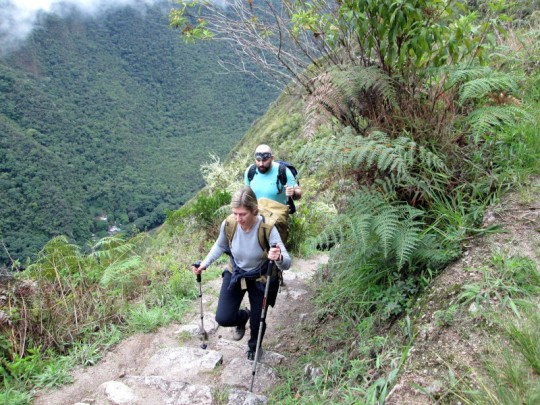
When to do the Inca Trail?
The Inca Trail closed in February for maintenance. Except this rainy month, it is possible to go out for the rest of the year. From December to March, it is the rainy season.
June, July and August are the coldest, driest months and therefore the most popular. If you are a regular hiker, physically prepared and with the necessary equipment, you can go trekking at any time of the year (except February).
The Inca Trail is very busy. To avoid the crowds, it is best to start from March to May or from September to November.
0 notes
Text
Salkantay
Day 1: Departure for the Salkantay trekking.
Early in the morning, departure by shared vehicle from Cusco to Mollepata (approximate travel time: between 3:00 and 3:30).

salkantay trek ours will continue our way to the Marcoccasa site (3300 m), the starting point of our walk. Once we arrive, we will prepare and meet the team that will accompany us, then we will begin the trek to join Challacancha where we will have lunch. Along the way seen on the Salkantay glacier.
We will continue the trekking to reach Soraypampa (3800 m), where our first camp will be installed.
Walking time: approximately 7 hours
Positive elevation: 3300 - 3800 (+ 500 meters)
Negative elevation: 0
Day 2: Salkantay trekking
Today we will leave Soraypampa early in the morning. This day will be the most difficult trekking, with the passage of a pass at 4600 m above sea level that we will cross shortly before lunch. Change of landscape and vegetation during the descent as we begin to penetrate the high jungle.
Arrival at the Challhuay camp (2900 m) for our second camp.
Walking time: approximately 9 hours
Positive elevation: 3800 - 4600 (+ 800 meters)
Negative elevation: 4600 - 2900 (- 1700 meters)
Day 3: Trekking from Salkantay
Trekking day with a descending profile, where you can see the different plantations in this area with a semi-tropical climate, such as citrus, coffee and coca. The weather softened before reaching the La Playa campground (2,100 m), near the Santa Teresa River.
Walking time: approximately 6 hours
Positive elevation: 0
Negative elevation: 2900 - 2100 (- 800 meters)
Day 4: Salkantay trekking
We will begin this new stage with an ancient Inca trail hike that will allow us to reach the Llactapata site (2590 m), which was both a resting place and a stage to reach the historic sanctuary of Machu Picchu. If conditions allow, we can see the remains of the lost city of the Incas. Then we will descend towards the Hydroelectric station where we will have lunch (1950 m). After that, we will walk to Aguas Calientes (approximately 3 hours), located at 2050 m.
During this walk, we will be able to know beautiful landscapes.
Notes: Time of
hike: around 8h
Difficulty: + 950 meters / -900m (2000m - 2950 - 2050)
This long stage will allow you to have a good view of the Machu Picchu site, from the Llactapata pass. However, depending on your physical condition at the time, it will be possible to avoid certain difficulties, joining directly the hydroelectric or choosing for the train. This will be decided at the moment, with your guide.
Options:
Hydroelectric Train - Aguas Calientes
Day 5: Arrival to Machu-Picchu on trekking from Salkantay trek
Leave the hotel early in the morning by bus to visit the archaeological remains of the citadel of Machu Picchu.
The visit to the site will last approximately two hours, then you will have free time to walk around the site, rest or attempt the ascent of Huayna-Picchu, this rocky outcrop that offers a panoramic view of Machu Picchu tours (not included) Dream of any traveler, legend has not yet revealed all its mysteries, the citadel of Machu Picchu continues to enchant and seduce visitors in search of magic. Its particular geographical location gives it an insolent and intoxicating beauty. The organization of the site in various districts and the geographical limitations of the region underline the greatness and genius of the Inca civilization ... Many mysteries remain to be discovered.
Return on foot (1 hour walk) or by bus (at your own expense) to Aguas-Calientes.
Departure by train to Ollantaytambo.
Continue by bus to Cusco.
Free dinner in Cusco.
Notes:
The return by train to Ollantaytambo is done in the "Shipping" (or Backpacking) category and is not accompanied.
In general, the return to Cusco is late in the afternoon or late in the afternoon, depending on the availability of trains. To benefit from better schedules, we offer a return to Ollantaytambo in the "Vistadome" category; The cars are equipped with panoramic roofs and panoramic windows to better appreciate the landscapes. You will find the supplement for this service in the "Options" section.
It is expressed in US dollars and per person. We cannot be responsible for any modification, change or refund reprogramming train.Horaires train time: 14:30 and 18:45 (Peru Rail) to availability (time and other services on request)
Options:
Vistadome train with sunroof, first class The bus between Machu-Picchu and Aguas-Calientes.
0 notes
Text
Look at the best places to spend the new year in Peru!
dLook at the best places to spend the new year in Peru! After all, what is the new year like in Peru?
Well, of course, when planning your trip to Peru, you should keep in mind that you can enjoy the holidays and then mend the tour to other incredible corners of the country. Then, first, we highlight some unmissable curiosities for you to enjoy New Year's Eve and then, let's separate some super-legal suggestions to continue the script, combined?
Yellow New Year's Eve in Cusco
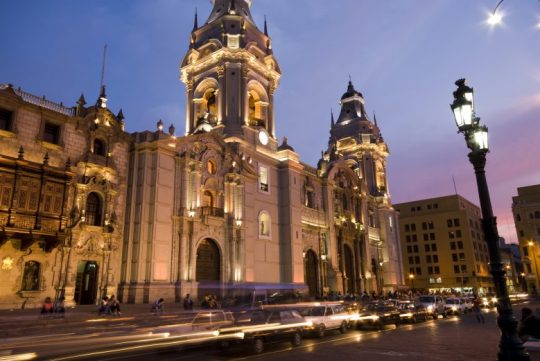
But beyond this deserved recognition and many other awards, Cusco itself already hides charms, spells and a unique energy that, sincerely, tripled during the New Year period in Peru. Well, to get an idea, in addition to all the attractions and beauties present throughout the year in the city, the town hall and local establishments are preparing a movie-worthy night for the shift.
There are live shows in the Plaza de Armas, parties in bars, hostels and hotels all night, special menus in restaurants and a beautiful display of fireworks to see and feel. Oh, and the whole city is covered in yellow, hugs, eats grapes (12, to be exact) and dreams of new wishes and requests for the new cycle. All this outdoors and with people from all over the world in a magical place!
New Year in Lima
Well, if the idea is to spend the New Year in Peru, in the center of the capital and enjoy the best of Lima, it can also be an excellent option. In addition, almost at the time of the turn, the streets tend to be full and full of life, especially on the coastal coast of Miraflores.
However, if you want a golden tip and experience the best fireworks display in the entire city, do so when choosing the hotel. After all, some have privileged views and incredible spaces, such as spectacular rooftops and terraces, where parties and services are held so that no one misses a moment of the shift.
In addition, the restaurants and bars of the capital also usually offer menus and schedules before and after midnight. So enjoy every minute!
And what to do after the new year in Peru?
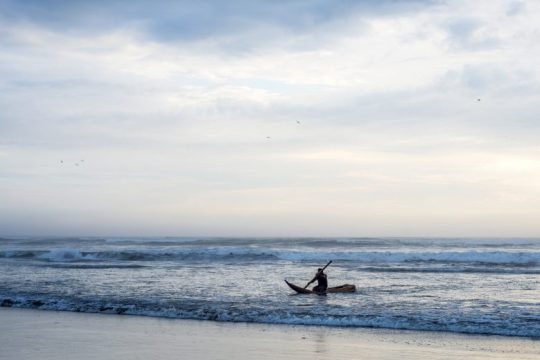
As we said, a New Year's trip in Peru will not be limited to New Year's Eve, right? So, the advice is to choose between Cusco and Lima for parties and then continue the trip, because there are many fascinating and incredible destinations.
Well, considering that going to Lima and Cusco will already include the Sacred Valley and Machu Picchu in the itinerary, we decided to show a little beyond this most famous route and suggest some alternative destinations! Lets go see it?
Northern Peru: after being surprised by Machu Picchu, Cusco and Lima, he has planned to combine the New Year of Peru with a chilling script of ancient pyramids, incredible beaches, mummies (one even with tattoos), archaeological sites older than the ¿ Incas and mystical and mysterious markets? Well, then it is good to look for cities like Chiclayo and Trujillo, since your New Year's Eve trip can be even more surprising than you think;
Mysteries of the Andes: what if the New Year's trip later extends through destinations full of lush nature while trying to discover some mysteries of the Andean peoples? Have you ever heard of the Nazca lines (enigmatic drawings of gigantic proportions that many researchers today are not sure how they were made) and the Paracas region (cradle of one of the most important and fabulous ecosystems in the world) ? So decide to try this script and be surprised;

Rota Sul: what would happen if we said that you can enjoy the New Year of Peru even more, with a road trip, linking Cusco with Lake Titicaca? Well, it is not surprising that the Southern Route of Peru is one of the most sought after by adventurers who seek to know in depth the origins of the Andean civilizations and be delighted with the magnificent beauty of this country

It may interest you:
Machu Picchu 2020 tikets
Salkantay Trek
Inti Raymi Peru
Short Inca Trail
Humantay Lake Tour
Machu Picchu Tours
Inka Jungle Trek
Rainbow mountain tour
Palcoyo Mountain
Maybe interest this blogs
Humantay
America Camelids
Machu Picchu Tips
Inca Trail trip
Sakantay Tips
Inca jungle trek tips
0 notes
Text
How to get from Cusco to Machu Picchu?
Ol TR TBreathe deeply as your adventure in Peru will begin now! Those who are on a scheduled trip or even daydreaming to visit the most fascinating country in South America certainly have in mind the traditional tour of the Sacred Valley and visit the most famous Inca ruins in the world. However, what many people ask when setting up the script is precisely how to get from Cusco to Machu Picchu.
Therefore, as good experts on the subject and connoisseurs from all corners of that region, we decided to prepare this publication exclusively to show you the most varied ways to get from Cusco to Machu Picchu and help you build the perfect script, within your profile of traveler and, of course, fits perfectly in your pocket. Lets go see it?
First, know some important things!
It is worth highlighting some important details and information before you even understand how to get from Cusco to Machu Picchu and not get bogged down when putting together your script. After all, it is good to remember that moving around Peru is not an easy task there, especially for those who try to do everything on their own, okay?
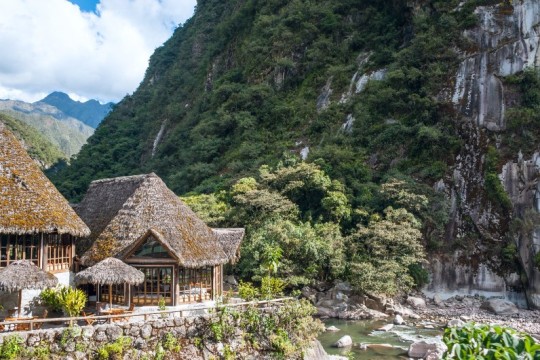
So, let's get some basic tips and information!
Cusco So, basically, your script should be done as follows: Lima - Cusco - Aguas Calientes - Machu Picchu;
Logistics in Peru is very special, both for public transport infrastructure and for the particular geography of the country. That is, keep in mind that traveling can only cause delays or even prevent you from reaching attractions;
Keep in mind that the new access rules to Machu Picchu determine the specific visiting hours, so it is good to make sure you arrive on time;
Prepare properly according to the chosen path;

It could be said that if you want to know how to get from Cusco to Machu Picchu more safely, keep in mind that it is through a specialized agency.
Know the different ways to get from Cusco to Machu Picchu
Now is adventure time! Going straight to the point, there are different ways and routes from Cusco to Machu Picchu, which makes it possible to explore the region in several ways, and here, they are all worth it!
What distinguishes each one, in fact, is the travel time available, the budget for your itinerary and, of course, what level of emotion or comfort you are looking for. To understand better, see below in detail how to get from Cusco to Machu Picchu in every way! Let's move on!
The most classic
You have probably heard of the trains to Machu Picchu! After all, it is the most comfortable and, we could say, the most classic of all options. However, it should be borne in mind that this mode of transport actually starts from different points, including Cusco!
In Peru, there are two companies that operate the trains to Machu Picchu: Inca Rail and Peru Rail. Both are excellent options and basically differ only by the available times. To know how to get from Cusco to Machu Picchu by train, look at the main stations in the region:
San Pedro: the newest train station in Machu Picchu, San Pedro is very close to the Plaza de Armas of Cusco and the travel time to Aguas Calientes is four hours;
Poroy: this station is 25 minutes from Cusco (so transportation is required) and the trip to Aguas Calientes takes three hours;
Ollantaytambo: it is already two hours by car from Cusco, however, it is the best option for those who wish to visit the Sacred Valley of the Incas and from there, go to Águas Calientes.
In short, it is easy to get from Cusco to Machu Picchu by train and, without a doubt, the most comfortable option for travelers and the landscape of the trip is indescribable. In addition, companies offer different types of trains and services on this route, from the simplest to the most luxurious.
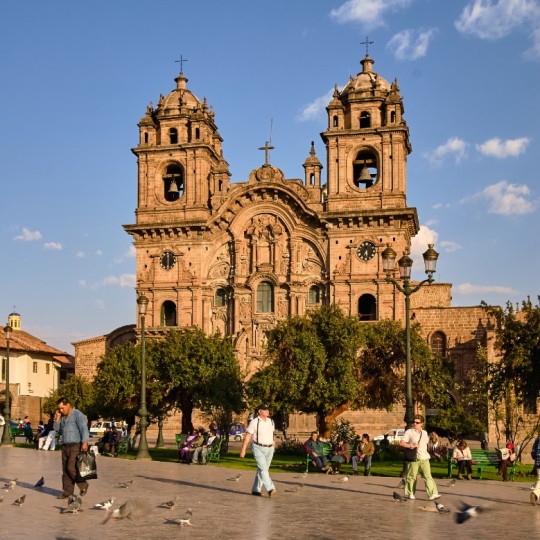
The most economical
How to get from Cusco to Machu Picchu for less? Yes, however, prepare your legs! After all, the form considered the most economical of all implies a certain physical effort and, on average, lasts approximately eight hours.
This is the famous road through the Machu Picchu dam, the closest point to Aguas Calientes that the trucks from Cusco arrive. That is, from there, the rest of the trip is on foot, in approximately two hours of walking along the train track.
The route is very busy and can also produce good images with the background landscape!
Most exciting
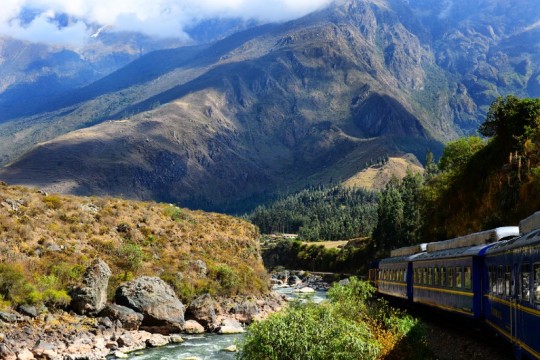
If you are looking for a little more excitement on your tour of Peru, then you have to go from Cusco to Machu Picchu by trekking. It is the famous Inca Trail, which allows you to walk along the original path opened by the ancient Indians (four days) or by alternative routes, such as the Salkantay Trail (five days).
There is even a faster option, called Inca Short Track, which only takes two days. It is noteworthy that the original route has a limitation of 500 visitors per day. Scenarios and experiences on all routes are guaranteed, which may include heavy snowfall, crystalline lagoons, archaeological sites, among other wonders.
TO KNOW MORE TIPS ON INCA ROADS
3 Day Inca Trail
Short Inca Trail
Inca Trail Tours 2020
Most complete

Finally, so as not to lose a minute of your experience in Peru, the most complete way to get from Cusco to Machu Picchu is by means of a closed package, which includes all transportation, tickets and guides during your stay in Cusco. region
In other words, this includes tours of the city of Cusco, tours of the Sacred Valley and visits to the Inca ruins with full support and without any worries.
It may interest you:
Choquequirao trek 4 days
Palcoyo mountain tour
Rainbow Mountain Tour
Machu picchu Tours
Humantay Lake Tour
Inti Raymi 2020
Others blogs maybe interest you:
Humantay
Machu Picchu
Rainbow mountain tips
inca Trail the Best Tour
Inti Raymi
Ollantaytambo
0 notes
Text
The charm of the Colca Valley
No matter how many times you are in capital of peru, this country will always surprise you. Especially if you do outside the ordinary itineraries, other lovely destinations arise in the country of the Incas.
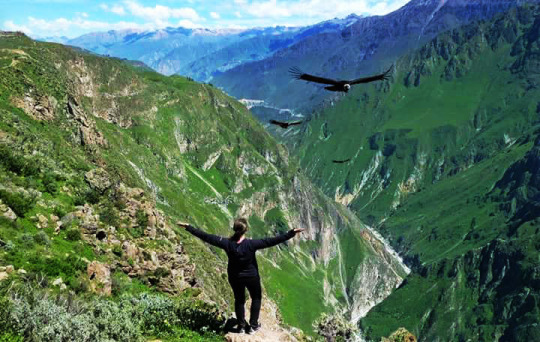
Peru is full of remote villages, largely unexplored, ancient cities, immense archeological sites, fascinating nature, mysteries that invite reflection and surrounding culture. And that is exactly why each part of this territory brings something special to make you fall in love.
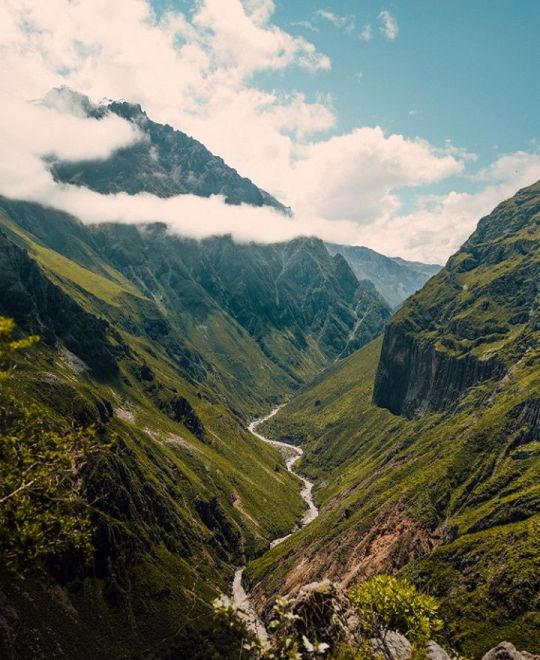
One of these places is the Colca Valley, attractive near the cities of Arequipa and Chivay, one of the deepest canyons in the world, which is impressive for its magnitude and beauty. When making a trip to this valley, Tierras Vivas advises spending at least two or three days acclimatized to the altitude in Cusco or in the nearby city, since it is 3,600 meters from sea level.
Valley Geography
The entire valley is 100 kilometers long, wide in nature, with a geography of the most moving landscapes on the planet. Its huge walls cover the entire Colca valley and the basin in harmony.
Exquisite agricultural platforms extend throughout the valley, incorporating a winding landscape that looks more like a brush on a canvas of a very detailed painter. In addition, there are imposing volcanoes, the best known in Peru, the Chachani, the Pichu Pichu and the iconic Misti.
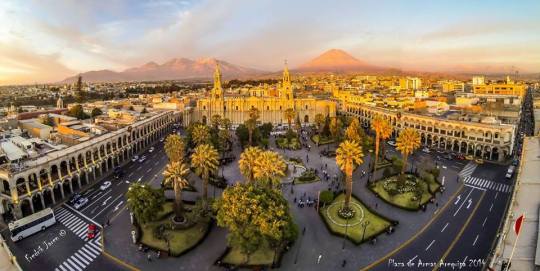
Cruz del Cóndor - A natural observation post
Indescribable feeling will be to contemplate the gift that nature offers in this valley. In Colca, there is this natural viewpoint, suitable for the observation of the entire valley, river and canyon, perfect for beautiful photos.
Also, get ready to enjoy the majestic flight of one of the largest birds in the world, the Condor, a bird typical of the Andean regions, which flies over the entire region and makes its home on the wide walls of the canyon.
The Condor, in addition to having giant wings that reach 3 meters from one end to the other, is considered sacred, a representative figure of the spiritual gods of heaven, by the Inca civilization.
Curiosity: Although the landscape of the valley is arid, it is also possible to observe from this viewpoint, some white mountains in the distance, are the famous Peruvian snow-capped peaks. One of them, the Mismi, is where there is a small lagoon, spring of the largest river in the world, the Amazon River, which crosses much of South America,
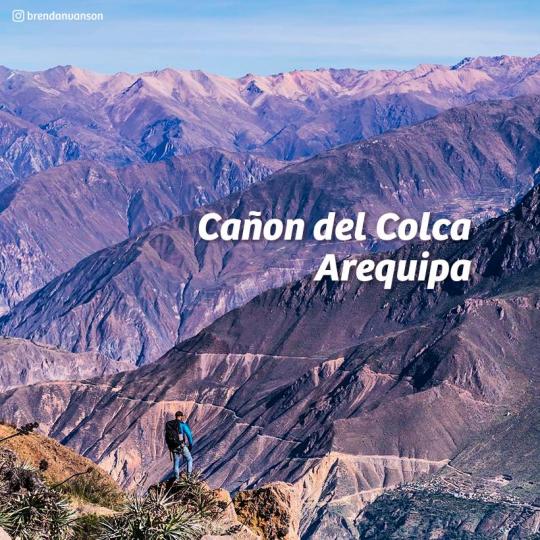
The immensity of the Colca Valley reserves even more attractions
More radical activities are carried out throughout the valley for those seeking adventure in nature. The exciting and challenging trekking routes and climbing rapids faced with a kayak on the Colca River are the favorite attractions.
Finally, the observation of other typical animals of the region, such as alpacas and vicuñas, improves the appearance of vast orange mountainous areas. These camelids are in many places in Peru a livelihood by removing wool for sale and making clothes, bags and other items.
It may interest you
machu picchu tours
rainbow mountain peru
palcoyo mountain peru
inca jungle trek peru
humantay
0 notes
Text
Hiram Bingham: one of the most luxurious trains in the world
It is curious how Peru offers many attractions for so many types of travelers, whether they are lovers of nature, history and culture, adventurers, admirers of remarkable spirituality, passionate lovers of romance or enthusiasts of luxury and comfort.
The latter, enthusiasts of luxury and comfort, reserve the most exquisite experiences, with beloved services, sublime typical activities, delicious cuisine, among other refinements.

In this wave of luxury, Peru offers one of its treasures to know Machu Picchu in style: the Belmond Hiram Bingham, the award-winning train, mentioned as one of the "7 best trains in the world" by the famous magazine Condé Nast United Kingdom Traveler, in 2010; He also voted "Best Train in the World" by the same magazine in 2011; and considered by NBC as the train that runs the 10 most beautiful routes in the world.
The trip between Cusco and Machu Picchu will be very fruitful and comfortable on board what is considered one of the best luxury trains in the world.
See our full article: The colorful mountain of Peru
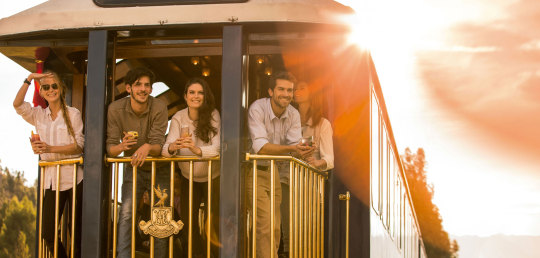
Belmond Hiram Bingham
This exclusive and luxurious train harmonizes exceptional experiences along the way. There are four wagons, two for the restaurant, one for the kitchen and one with a bar to observe the beautiful landscape of the Sacred Valley of the Incas, along the way.
It comfortably transports 84 passengers and presents a very refined decoration in the style of the 20s. The best reception in service offers first class entertainment and sophisticated Peruvian cuisine.
See our full article >> Laguna Humantay
A personalized service is offered early on boarding, even at Poroy station, where Hiram Bingham departs, with a special welcome toast at the receptive cocktail with wine or champagne and fruit juice. In the rainy season, between December and March, departures are made from the town of Urubamba.
On board the train, passengers sit at elegant tables in a well-decorated setting in the dining cars to taste the best of the renowned Peruvian cuisine. The tasty and select lunch with starter, main course and dessert is served with typical Peruvian ingredients. Drinks are also traditional, including wines, the famous pisco sour, juices and soft drinks.
Entertainment is provided by music and traditional Andean dance shows, and the fascinating natural landscapes of the Sacred Valley of the Incas, which can be seen from the special observation car, which has huge windows and a panoramic roof. This is a good time to take beautiful souvenir photos.
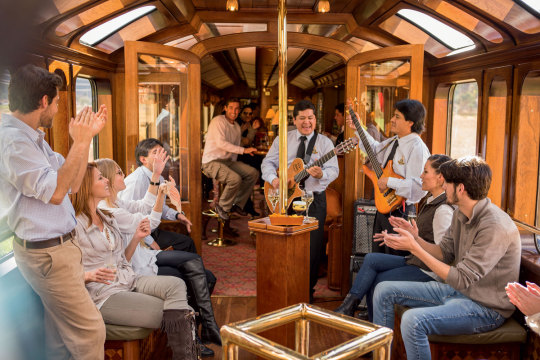
Hiram Bingham has staff on board with, among other professionals, guides who tell stories about the route, the Sacred Valley, the Incas and their culture and history, and travel details.
On the way back from Machu Picchu, the services of this train are also exclusive, with a gourmet Peruvian dinner and typical Peruvian wine. Dinner can be even more special if a couple in love wants something more romantic by candlelight along with delicacies that are served with grace.Hiram Bingham: one of the most luxurious trains in the world
As you can see, the trip between Cusco and Machu Picchu can be simple, but it can be exquisite in this way, and always with impeccable service, especially if you are aboard Belmond Hiram Bingham.
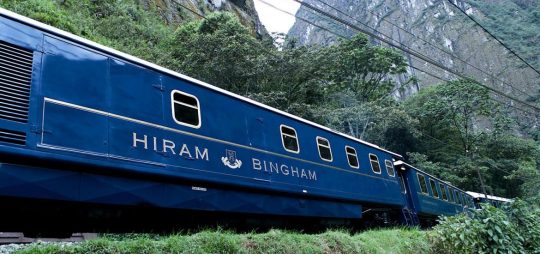
It may interest you:
Salkantay Trek
Short Inca Trail
Rainbow Mountain Peru
Machu Picchu 2 days 1 night
0 notes
Text
Meet the most luxurious hotels in Peru in South America!

One of the most important elements of a trip is undoubtedly accommodation. In Viagens Machu Picchu we believe that the hotel is part of the experience and, if chosen well, can be the great differential of the trip. Remember: it is essential that it be a comfortable, quiet, well located and well attended place.
Now, if you want to spend unforgettable and special days, with exclusive services, personalized service, in privileged places, with good gastronomy, elegance, tranquility and luxury, we will present the Belmond Hotel chain, which has the best hotels in the world. They are present in the Americas, Europe, Africa and Asia and promise to make your trip extraordinary.
The Belmond chain is also present in Peru, with excellent hotel options throughout the country, in addition to operating one of the most luxurious trains in the world, the Belmond Hiram Bingham train, which takes travelers to Machu Picchu.
WHY CHOOSE BELMOND LUXURY HOTELS ON YOUR TRIP TO PERU?
Have you considered staying in the best and most luxurious hotels in South America? Learn more about Belmond hotels:
All offer comfortable, spacious and elegant accommodation, decorated with elements of Peruvian local culture, with privileged views and impeccable room service.
But the big difference, no doubt, are the services offered within the hotels. Each has its own services, according to the region in which they are, for example: spas with a variety of Andean-style treatments and massages, private and heated pools, horse riding, beauty salon, rafting, yoga ... Not to mention the good food. with international or typically Peruvian dishes, prepared with a lot of sophistication.
In addition to many amenities, such as butler services, additional oxygen in the rooms and even an own train station that takes you directly to Aguas Calientes.
See below the main features of Belmond hotels in Peru:
LIMA
BELMOND MIRAFLORES PARK HOTEL
Located in one of the main districts of the Peruvian capital of Miraflores, this hotel has a luxurious lobby, classic-style rooms and impresses with its pool on the 11th floor overlooking the Pacific Ocean.
Learn all that Miraflores Park has to offer:
Rooms: 89 rooms and suites, all equipped with TV, safe, minibar, coffee and tea. Free daily delivery of newspapers and Prija bath products.
Services included: buffet breakfast, afternoon tea for 2 people, free internet, concierge service, non-alcoholic drinks during the day and alcoholic beverages such as wines and cocktails, free during the time selected by the guest.
Other services available: air conditioning, laundry, concierge and business center.
Rest and recreation spaces: Zest Spa, with special massages, sauna, outdoor pool and gym.
Restaurants and bars: Skylight, with international dishes. The Observatory, with international dishes. Beautiful bar, drinks, pisco sour and more.
Check-in: 3 pm / Check-out: noon.
What makes this hotel special: its infinite view of the Pacific Ocean, the decoration of the rooms and common areas, and the sunset by the pool.
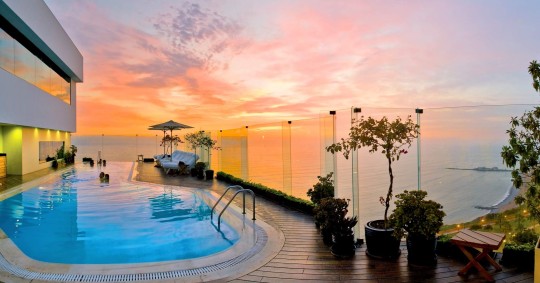
CUSCO
BELMOND HOTEL MONASTERY
Discover the charms of Cusco through this hotel, located a few minutes from the Plaza de Armas, in an old city monastery. Decorated with original antique artworks, it offers guests an incomparable historical charm.
Learn all that the Belmond Monastery has to offer:
Rooms: 126 accommodations, including some up to 2 floors with private balconies, marble elements, unique décor and maximum comfort. Equipped with TV, minibar, mineral water, safe and DVD. All with extra oxygen option to help acclimatize.
Services included: buffet breakfast, free internet, air conditioning.
Other services available: laundry, concierge, business center, messaging.
Rest and leisure spaces: hairdresser, nursery, gym, indoor stores, massage therapist.
Restaurants and bars: The Tupay with international dishes. Illariy, with the best of Andean cuisine. Lobby Bar, drinks, pisco sour and more.
Entry: 3 pm / Departure: 11 am
What makes this hotel special: it is a national historical landmark. Its central courtyard has a 300-year-old creed, surrounded by gardens and famous stone cloisters. The oxygen was channeled to the rooms, avoiding altitude sickness.

BELMOND NAZARENIAN PALACE
This is the most luxurious hotel option in Cusco, which offers an unforgettable experience for travelers seeking sophistication. Rooms with stone walls with frescoes from the colonial era, wooden and marble furniture, butler service, spa, pool and more.
Learn all that the Nazarene Palace has to offer:
Rooms: 55 rooms and suites, all equipped with TV, safe, minibar, coffee and tea. Free daily delivery of newspapers and Prija bath products.
Services included: buffet breakfast, free internet, air conditioning, welcome drink.
Other services available: laundry, concierge.
Rest and recreation spaces: Hypnôze Spa, with Hammam massage and bath, the only outdoor heated pool in the city.
Restaurants and bars: Senzo Restaurant, with international dishes. Senzo Bar, drinks, pisco sour and more.
Check-in: 2 pm / Check-out: noon.
What makes this hotel special: it is a hotel built in the Inca ruins, with historical elements that stand out throughout the hotel. Gold framed paintings. Heated outdoor pool.
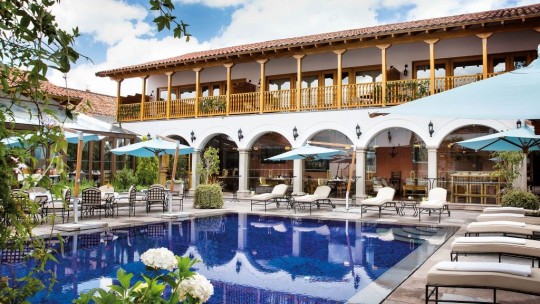
THE INCAS' SACRED VALLEY:
BELMOND SACRED RIVER
Ideal option for those seeking tranquility, comfort and luxury. This hotel is located on the banks of the Urubamba River within the Sacred Valley of the Incas, so it has privileged views of the region and many exclusive services and amenities.
Rooms: It has 23 rooms and suites, with a decoration that combines regional and European elements. They have heated wooden floors, a panoramic terrace and a Swiss shower facing the river. With safe and TV.
Services included: breakfast, free internet, air conditioning.
Other services available: the hotel's own train station for Machu Picchu, concierge, 24-hour room service, business center.
Rest and recreation spaces: bicycle rental, yoga classes, swimming pool, horse riding, rafiting, sauna, spa with a wide range of Andean-style massages, shops, beauty services, among others.
Restaurants and indoor bars: Pachamanca, a technique that involves placing hot stones in a hole to cook ingredients. El Huerto Bar, drinks, pisco sour and more.
Entry: 3 pm / Departure: 11 am
What makes this hotel special: its location, overlooking the mountains of the Sacred Valley of the Incas. All services available with numerous activities for all types of tourists. Own train station. Information withdrawn Do you like it? All these 5 star hotels in Peru are at your disposal! Get in touch with the Machupicchu Travel staff, schedule your trip and guarantee the stay in the best luxury hotels package of Sul.Confira Latina that we have prepared for you: Peru By Belmond! Includes 8 days to know the main attractions of Peru and 7 nights accommodation at Belmond hotels.
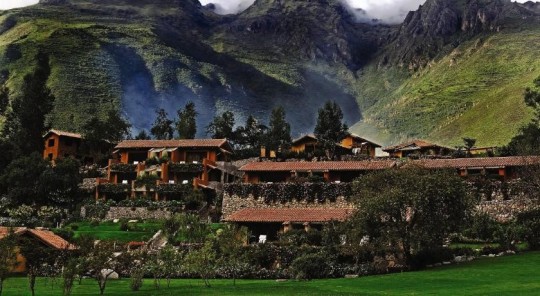
It may interest you:
Machu Picchu tickets 2020
Salkantay Trek
Inti raymi 2020
Palcoyo Mountain
Rainbow Mountain
Machu Picchu Tours
#Machu Picchu Tours#Rainbow Mountain#Palcoyo Mountain#Salkantay Trek#Inti raymi 2020#Machu Picchu tickets 2020#Salkantay#petite#Peru Travel#peru#Cusco#hotel cusco#trevor belmont#BELMOND SACRED RIVER#BELMOND NAZARENIAN PALACE#BELMOND HOTEL MONASTERY
0 notes
Text
INCA ROAD 2 DAYS 1 NIGHT
In this program we will live one of the best experiences in Cusco, we will do the 2 Day Inca Trail and 1 night, we will enjoy unique places and visit the citadel of Machu Picchu.
During the trip we can appreciate the natural beauty that is present throughout our trip, it is certainly an experience that many people around the world want to experience.
This wonderful Inca trail crosses only a small part of the entire Peruvian jungle, composed of protected flora and fauna, this path will take us to different Inca archeological sites. Today it is a privilege for us to offer the experience of traveling the same paths that our ancestors used in their pilgrimage to the sacred citadel of Machu Picchu.
ITINERARY
DAY 1: Cusco - Km 104 - Wiñaywayna - Aguas Calientes
Early in the morning we will leave the city of Cusco. Traveling to Ollantaytambo, where you will board the train that goes to Aguas Calientes, this train will make a special stop at km 104, where we get off to start our walk on the Inca Trail. The Inca Trail begins with a walk to Chachabamba located at 2270 meters, then continues walking until you reach Wiñaywayna, located at 2,650 m., One of the most important archaeological sites after Machu Picchu. The day is almost over and the path leads to the Puerta del Sol “Inti Punku” with the few rays of the sun, you can enjoy the sun in Machu Picchu, remember that Machu Picchu is located at 2400 meters above sea level, If you already You were in Cusco, height will not be a problem. At the end of the day we will arrive in Aguas Calientes (City of Machu Picchu),
DAY 2: Aguas Calientes - Machu Picchu Sanctuary - Cusco
Early in the morning we will have breakfast at the hotel. Then we will go to the bus station located in the lower part of the city, in a 30-minute trip we will go to the sacred city of Machu Picchu. Upon arrival at the citadel around 6 am, our guide will welcome us and give us detailed information about Machu Picchu, the history and culture of the Incas. The guided tour will last approximately 2 hours, after which you can visit Machu Picchu freely until a prudent hour, taking into account the return train schedule.
After the tour, you will get off to Aguas Calientes by bus and have a free afternoon to explore the city or visit the hot springs at the right time, we will board the train back to take us to the Ollantaytambo station, in this place a team that will Company will be waiting. to help you and return to Cusco

It may interest you: -
Humantay Lake Tour
Sacred Valley Tour
Palcoyo Mountain Tour
Rainbow mountain tour
Inca Jungle Trek
#Inca Jungle Trek Rainbow mountain tour Palcoyo Mountain Tour Sacred Valley Tour Humantay Lake Tour 2 Day Inca Trail#Inca Jungle Trek#Rainbow mountain tour#Palcoyo Mountain Tour#Sacred Valley Tour#Humantay Lake Tour#2 Day Inca Trail
0 notes
Text
Inca Jungle Trail 5 Days / 4 Nights

Travel Introduction:
The Inca Jungle Trek is one of the most popular tours from Cusco to Machu Picchu. It is a mixture of different adrenaline activities. Start your bike ride from 4,000 meters to 1,500 meters above sea level! We will walk along an original Inca trail and after a long day of walking we will arrive at the Qoqalmayo Spa to take a relaxing bath. As part of our adventure is to cross the 200-meter high mountains in zip line activity, we will have the opportunity to see Machu Picchu from another perspective walking along the banks of the Urubamba River and the last day will be dedicated to the visit of the City Inca early in the morning to enjoy the sunrise.
Featured
Walking tour of the city of Cusco
Descent of 4,000 meters above sea level.
Rafting on the Santa María River
Jungle Walk on an Original Inca Trail
Enjoy the thermal baths of Qoqalmayo
6 cables to cross the longest zip line in Latin America
Hike around the mountain to Machu Picchu
Explore the city of Machu Picchu.
Itinerary:
Day 1: Cusco - Walking Tour
Our trip begins in Cusco with a walk to the main attractions, where the guide will explain everything, such as markets, street names, people, Peruvian products, customs, vacations, etc. In the evening, the guide will give a talk about the next four days of his expedition to the jungle to Machu Picchu.
Day 2: Cusco - Open Malaga - Santa María
Shortly after breakfast, our car will pick us up from its hotels and take us through the Sacred Valley to Abra Málaga, which is 4000 meters above sea level. Upon reaching the highest point, you will receive safety instructions before starting to ride a bike and feel that the adrenaline descends about 60 kilometers in approximately 2 to 3 hours crossing some water currents and stopping at the viewpoints to finally reach the city of Huamanmarca, where we will board the bus. who will take us to Santa Maria for lunch. In the afternoon it is time to face the river and catch the best rapids during an hour and a half of adventure! We return to our lodge for dinner and listen to our guide all the instructions for the next day. (All the foods)
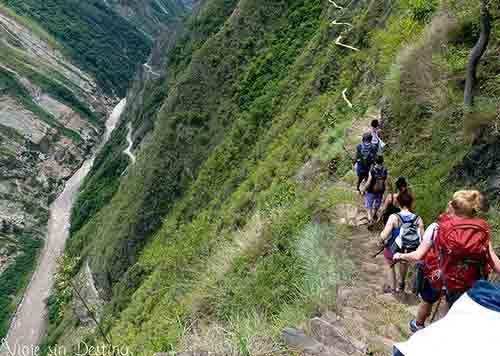
Day 3: Santa María - Qoqalmayo - Santa Teresa
Today is the day !!! We will continue our trek to Machu Picchu to the jungle to visit the homes of the locals and learn about coffee production, coca plantations and different varieties of organic fruits. Feel free to feel the difference by having a cup of coffee directly from the field. We will continue our walk along an original Inca trail, enjoying the beautiful landscape and listening to the guide's explanation and then having lunch at a local restaurant in the high jungle region of Cusco. After lunch, we will take a break in the thermal baths to relax our muscles and after approximately 1 hour our bus will be waiting to take us to Santa Teresa for dinner. (All the foods)
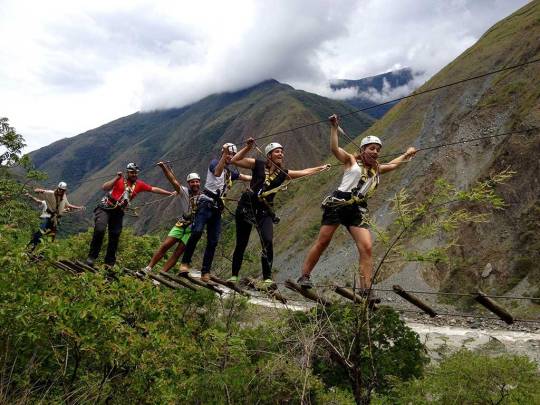
Day 4: Santa Teresa - Aguas Calientes
After breakfast we start with the zip line activity. There are 5 different cables and a suspension bridge. It is a fun and safe activity! Then we will go to the hydroelectric dam for lunch and then we will have a pleasant walk through the beautiful subtropical vegetation at the bottom of the mountain of Machu Picchu from where we will have the first view of the city from the bottom and finally we will reach Aguas Calientes. (All the foods).
Día 5: Machu Picchu - Cusco
We recommend that you take the bus early in the morning to have the opportunity to see the sunrise in the Citadel. After 2 hours of guided tour of the most important sectors with our guide, you will have enough time to explore this magical place, considered a sacred city! We will take the bus again to return to Aguas Calientes and take the train back to Cusco. (Breakfast at the hotel).
It may interest you:
- Salkantay Trek
- Palcoyo Mountain
- Machu Picchu Tickets
#Salkantay Trek Distance#Palcoyo Mountain#Machu Picchu Tickets#Salkantay Trek#Inca Jungle Trek#Cusco#Machu Picchu#Aguas Calientes#Inca Jungle#Inca Jungle Trail 5 Days / 4 Nights#Inca Jungle Trail 5 Days
0 notes
Text
7 ways to go to Machu Picchu
3 - Salkantay Trail :There are several ways to get to Machu Picchu. Each has advantages and disadvantages, ranging from price to travel time. For example, taking a van can cost up to ten times less than traveling on the expensive train. However, your travel time will last four times longer.
The main ways to get from Cusco to Machu Picchu are:
Train
Van + hydroelectric route;
Salkantay Trail;
Inca Trail;
For the clues;
Crash track;
Own account.
In this article, we will talk about each one of them. Check it!
It all starts in Cusco ...
Your trip to Machu Picchu will surely begin with Cusco, the ancient capital of the Inca Empire. All the main roads leading to MaPu, the city that the Spaniards never found due to its remote location, leave here. Those who go by train or on the Inca trail will still have to get a little closer to the historic site of Ollantaytambo.
... and ends in Aguas Calientes
It is also important to know that all roads lead first to Aguas Calientes, the city at the foot of Machu Picchu and that it serves as a base for tourists. Restaurants, hotels, markets, exchange houses, ATMs can be found in Aguas Calientes and you may have to spend at least one night here.
From Cusco and Ollantaytambo to Aguas Calientes
1 - En tren
From black: from Cusco to Ollantaytambo
From yellow: from train
It is the fastest and most comfortable way to get to Machu Picchu. If you have a tight itinerary and want to make the trip as a round trip from Cusco on the same day, this is the only way to do it. But be prepared to leave early. The disadvantage is by far the price. The train is the most expensive way, from $ 55 to $ 250 per section.
Duration: 2.5 hours (from Ollantaytambo)
Price: from US $ 110 round trip
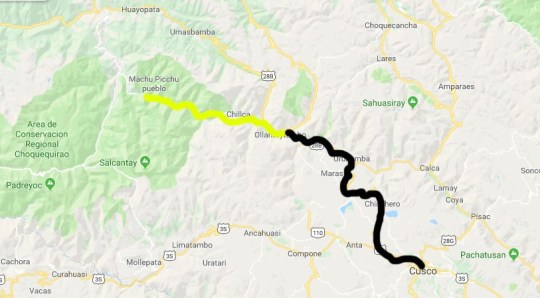
2 - by van + track by the hydroelectric
This is the favorite backpackers alternative, since it combines speed with good value for money. It is much longer than the train: it is 6 hours by road, plus 2 hours on foot from the dam to Aguas Calentes, but it also costs much less: PER 35 (Peruvian soles), or something like $ 10. If you choose this option You will have to book a day trip and another day to see Machu Picchu and return to Cusco.
Duration: 8 hours (6 hours by van + 2 hours and a half on foot)
Price: from PER 70
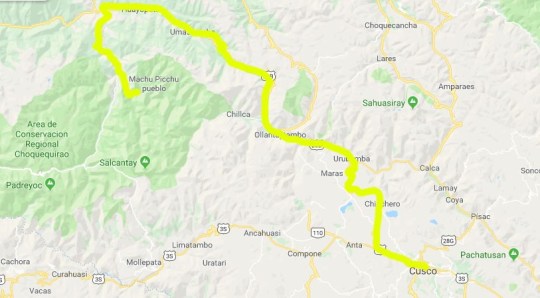
3 - Salkantay Trail
This trail is named after the snowy Salkantay. The classic departure is from the city of Mollepata, near where the Humantay Lagoon is located and lasts 4 days and 3 nights to Aguas Calientes, going Thursday to Machu Picchu. They are about 80 kilometers, which can be traveled autonomously without authorization.
Distance: 80 kilometers
Duration: 5 days
Price: if you are hired by an agency, you can start from US $ 100 (group of up to 15 people, with meals, transportation and tent only for the period of the trail)
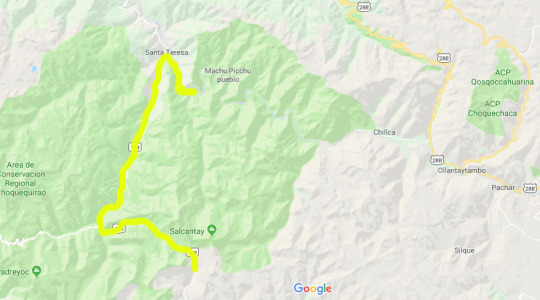
4 - Inca Trail
The classic Inca Trail is regulated by the Peruvian government, so only a limited number of people can walk per day. If it is your idea to do so, hire the service of a registered guide in advance. You can find it for $ 200 (all inclusive except Machu Picchu). It takes a 3-day hike from Ollantaytambo to Águas Calientes, on a 40-kilometer course, another day to climb Machu Picchu and visit the park.
Distance: 40 kilometers
Duration: 4 days
Price: from US $ 200
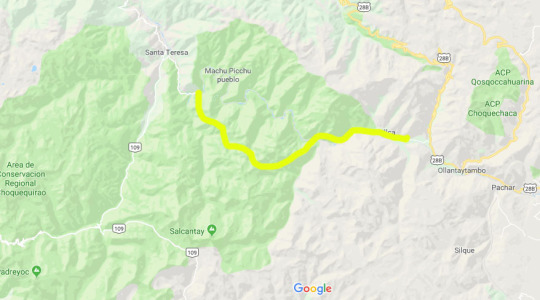
5 - On the trails of Ollantaytambo
This is only for the strong and physically fit. Some walk the almost 50 kilometers between Ollantaytambo and Aguas Calientes by train. The hike is difficult due to the distance. Who did it, says it does not require much strength, since it is a slope of more than a thousand meters between the beginning and the end of the road, so it is always walking "downhill." Whoever doubts it, just read the comments of this track log on Wikilock.
Distance: 48 kilometers
Duration: 12 hours fast steps
Price: free
6 - By Choquequirao
We did not, but it is out of curiosity or adventurous spirit: like Machu Picchu, Choquequirao is an Inca city that was not discovered by the Spaniards, and remains virtually intact with respect to human action. It has an area at least three times larger than Machu Picchu and there is a path that joins the two sites, which requires a 5-day walk to get from one city to another.
But the most exhausting is not that. Choquequirao is in the middle of nowhere and to get there you have to walk for at least 4 days from a city called San Pedro de Cachora. An adventure of 132 kilometers.
Distance: 132 kilometers
Duration: at least 8 days

7 - On your own
The idea is to reach Aguas Calientes, from Cusco, without having to take any agency transfer. To do this, you must combine public transport, taxi and walk.
Off the trails, this is the longest way to get to Machu Picchu and you will spend more than going by van. The good thing about this is having closer contact with the locals, who move in this way.
The first step is to get to Santa Rosa by bus. From Cusco, the buses leave the terminal of Antonio Lorena street, in the center of the city. It is about six hours of capsules at the price of PEN 20. Then, you must take another transport service, usually a van, to Santa Teresa, for PEN 10, a duration of one hour. Finally, a taxi to the hydroelectric dam, on PEN 20, or walk the 20 kilometers on a dirt road.
To return, you can take the train or walk to the hydroelectric dam and then close with a van back to Cusco. Or walk to Santa Teresa.
It may interest you :
Inti Raymi Peru
Salkantay Trek
Palcoyo Mountain Tour
How Many Days in Cusco
Salkantay Trek Distance
#Salkantay Trek Distance#How Many Days in Cusco#Palcoyo Mountain Tour#Salkantay Trek#Inti Raymi Peru#Choquequirao#Salkantay Trail#Machu Picchu
0 notes
Photo

Classic Inca Trail to Machu Picchu
The Classic Inca Trail To Machu Picchu or Hiking the Inca Trail to Machu Picchu is the most famous and popular Machu Picchu hike and even one of the most famous and favourite treks in the world. Discover one of the most pristine landscapes of Peru and experience an Andean journey to the Sanctuary of Machu Picchu. Hike the Inca Trail through high mountain passes, highland meadows and tropical cloud forests. This 4 day hike to Machu Picchu ends up by entering this Incan sanctuary through the famous Sun´s Gate ("Inti Punku" in Quechua native language). Be one of the many adventurers from around the world, who has successfully done this moderate to difficult Machu Picchu 4 day hike.
Enjoy the Hiking the Inca Trail to Machu Picchu with many archaeological Inka sites along the way and travel completely in touch with Mother Earth ("Pachamama" in Quechua native language) revealing to you its surrounding snow-peaked mountains, mountain rivers and amazing diversity of flora and fauna. This 4 day Inca Trail hike is absolutely stunning. Join the group and tie up your shoes.
#inca trail#inca trail tours#inca trail trek#machu picchu#trekking#hiking#adventure#adventure travel#peru holidays#peru treks#travel#travel tour group
0 notes
Photo

Inca Trail Peru
Hike the Inca Trail
The Inca Trail trek to the Sacred site begins either at Km 82, Piscacucho, or at km 88 Qorihuayrachina, at 2600m. In order to reach km 82 hikers are transported by their tour operator in a minibus on the road that goes to Quillabamba. From Piri onward the road follows the riverbank and ends at km 82, where ther is a bridge.
The walk to Huayllabamba, following the Cusichaca river, is about 3 hrs and isn't too arduous. Beyond Hauyllabamba, a popular camping sport for tour groups, there is a camping places about an hour ahead, at Llulluchayoc (3200m). A punishing 1 1/2 hr climb further is Llulluchapampa, an ideal meadow for camping. If you have the energy to reach this point, it will make the second day easier because the next stage, the ascent to the first pass, Warmiwañuska (Dead Women's pass) at 4200 m, is utterly exhausting 2 1/2 hrs.
Afterwards take the steep path downhill to the Pacaymayo valley, Beware of slipping on the Inca steps rain. You could camp by a stream at the botton (1 1/2 hrs from the first pass). It is no longer permitted to camp at Runkuracay, on the way up to the to the second pass (a much easier climb 3850 m). Magnificent views near the summit in clear weather. A good overnight place is about 30 mins past the Inca ruins at Sayacmarca (3500m), about an hour on after the top of the second pass.
A gentle 2 hr climb on a fine stone highway leads through an Inca tunnel to the third pass. near the top there's a spectacular view of the entire Vilcabamba range. You descend to Inca ruins at Phuyupatamarca (3650 m), well worth a long visit, even camping overnight. There is a 'Tourist bathroom' here where water can be collected (but purify it before drinking).
From there, steps go downhill to the impressive ruins of Wiñay Wayna, (2700 m) with views of the recently cleared terraces of Intipata. Access is possible, but the trail is not easily visible. There is a small campsite.
The path from this point goes more or less level through jungle until the steep staircase up to the Intipunku (2 hrs), where there's a magnificent view of Machu Picchu, espcially at dawn, with the sun alternately in and out, clouds sometimes obscuring the ruins, sometimes leaving them clear.
Inca Trail Huayna Picchu mountain
This is a new rule from the government; Inca Trail Huayna Picchu passes are only available for purchase with the general Machu Picchu entry ticket and there is a special entry ticket for the Inca Trail which does not allow this add-on. When you do the Inca Trail you are among the only people who enter Machu Picchu via the Sun Gate (rather than the general public entrance) and you receive a special Machu Picchu tour from there. If you want to purchase a Huayna Picchu pass you will need to buy a new entry ticket for Machu Picchu as well (total USD $60 per person) – note that depending on the speed of your group you may actually have to sacrifice part of your Machu Picchu tour in order to climb Huayna Picchu in the second group. Ask us if you really want to climb Huayna Picchu – otherwise we do not recommend it for the Inca Trail.
If you really want to do this Click Here
Inca Trail Booking
Inca Trail permit availability
Since only 500 trek permits are issued per day for the Inca Trail tours (trek permits are also required for the porters and cooks) it is important to try to make a trek reservation as far ahead as possible. There is no clear rule as to how far ahead be enough to guarantee you a space since this depends on demand.
December, January, March: 3-5 weeks in advance
April, October, November: 6-8 weeks in advance
May, September: 2-3 months in advance
June, July, and August: 3-4 months in advance
Inca Trail reservation
Tierras Vivas Tour Operator will guarantee the spaces booked provided:
The booking has been first confirmed by our department booking by e-mail, this meaning that spaces are available on the Inca Trail for the requested information at the moment of the booking. The full passenger data have been provided and the required deposit has been paid for.
How to book the Inca Trail
The following client information is requested for any Inca Trail booking: Complete names and surnames, Nationality, Passport number, Date of Birth and Gender. The exact information provided by you will be submitted to the governmental institution in charge of regulating the access to the Inca Trail and will be included in the official permit to enter the Inca Trail on the requested date. Should there be any change in the above-mentioned data (ie. New passport number), we kindly request you to inform the department booking at Tierras Vivas Tour Operator via email as soon as possible.
The government reserves the right not to allow the entry to any visitor whose data are not the exact ones as those in the official permit. Tierras Vivas Tour Operator excludes any responsibility for a no entry in case the passenger information has changed without prior notice to us. Departure dates to Classic Inca Trail to Machu Picchu Daily departures are available along the year. Exception: one-month closing period of all Inca Trail routes in February. Please contact us to check departures to alternative routes. All Inca Trail departures are subject to government space availability, please check the following website: Ministerio de Cultura > Consultas > Centro Arqueológico: please select Camino Inca > Please select year and month.
#inca trail#hikers#hiking#trekking#adventure travel#adventure#machu picchu#machupicchu#inca trail tours#inca trail trek#peru travel#peru holidays#holidays#vacation#luxury travel
1 note
·
View note